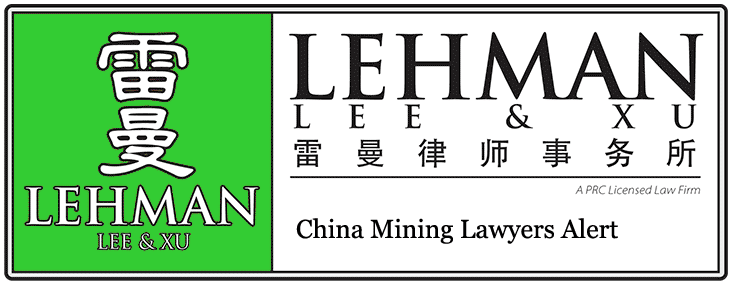
| If you would like us to send you new issues by e-mail each month, please click here to subscribe. There is no charge for this service. If not, please click here to unsubscribe (Please provide the correct Email address which you received our message or forward the message which you received to us for further process). |
 |
|
LEHMAN, LEE & XU China & Mongolian Lawyers
|
|
China Mining Lawyers Alert
|
|
May 2012
|
The China Law News keeps you on top of business, economic and political events in the China. |
|
|
|
In the News |
Copper output to hit 16m tons by 2015 |
CHINA'S total annual copper processing capacity will reach 16 million tons by 2015 with the addition of another 3.15 million tons. But Wang Biwen, head of the copper division under the China Nonferrous Metals Fabrication Industry Association, said the annual growth rate is seen to be lower than the double-digit gain in the five years through 2010. "A weak export market, as a result of uncertainties in the global economy, means copper processors have to focus on the domestic market in the coming years,'' Wang told a conference yesterday on the sidelines of the 6th China International Exhibition for Copper Industry, Asia's largest copper industry show. China's copper product output rose 17.8 percent to 10.28 million tons last year, or over half of the world's total. Consumption was flat at 10.56 million tons last year, the association said.
|
Steelmaker considers moving main factory out of Shanghai |
BAOSTEEL Group Corp, parent company of China's biggest listed steelmaker, is considering moving the production capacity of its main factory out of Shanghai, Chairman Xu Lejiang said yesterday. "There's not a doubt that the steel industry is a huge emitter of carbon dioxide. We are facing tremendous pressure from the government, society and ourselves to meet environmental protection standards," Xu said. "Moving may be our major task in the next few years." Shougang Corp, a Beijing-based steelmaker, moved its main factory out of the capital after the government introduced measures designed to conserve energy and reduce pollution in China's major cities. Shougang, which was Beijing's major industrial polluter, moved its main factory to Hebei Province in 2008. "Shougang's today is our tomorrow," Xu said. "We will take proactive actions in crossing the threshold. In the next 10 years, production in Shanghai will fall by 3 million tons. The forgone capacity will be supplemented by other factories." According to industry insiders, Baosteel received government approval at the end of April for a 10 million ton plant in Zhanjiang, a port city in Guangdong Province. Xu confirmed the news, but said the official papers had yet to be received, web portal NetEase reported yesterday. Baosteel's plan to expand in the southern region was phased in more than three years ago, but the steelmaker failed to get approval from the National Development and Reform Commission at a time when the global financial crisis slashed demand and there were strict controls on overcapacity. "Steelmakers' profitability continues to deteriorate," the Workers' Daily reported last week citing Li Xinchuang, an official of the China Steel Industry Association. "According to the forecast made by the Ministry of Industry and Information Technology, the domestic demand for steel will reach 710 million tons by 2015, while the production stays around 810 million tons. The gap indicates oversupply." Chinese steelmakers posted combined losses of more than a billion yuan (US$158.2 million) in the first quarter, the first industry-wide losses in 12 years, due to slowed demand on weakening exports and government curbs on property, Li said. "The steelmakers were the worst performers among the industrial producers. Their profits fell the most compared to others in the first three months," he added. "Overcapacity will be eliminated through mergers in the future." NetEase said Wuhan Iron and Steel (Group) Corp also received approval for a 10 million ton factory in Fangchenggang, a port city in Guangxi Zhuang Autonomous Region that borders Guangdong. |
|
|
|
|